So anyway, if ever we have the money and the means (and that is by no means an impossibility) what would we be looking for as a perfect boat for our needs?
I must address a critical matter straight away and that is the balance of priorities between aesthetics, sailing ability and accommodation ...
From the top, let's rule out ocean crossings and world girdling blue water cruising. It's not our thing. We're talking live-aboard in the UK for most or all of the year and spending the summers cruising around Northern Europe.
We like to day sail from location to location and then spend at least a day in each new place exploring. Ideally, especially when there is just the two of us aboard, we like to keep the legs at sea below 8 hours duration. So straight away we can see that, normally, in any 48 hour period we are aiming to spend no more than 8 hours at sea (and therefore 40 hours at anchor, in a harbour or in a marina)
So less than a sixth, or about 15%, of our time aboard will be spent at sea ... at most because that doesn't take into account the winter period when we'll be tucked up in a suitable sheltered berth nor does it allow for the times when we'd spend two or three days in one place (although to be fair nor does it allow for the probably rarer occasions when we get under way two or more days on the trot or put in a passage).
Anyway, whatever the figure might ultimately be, clearly we are going to be spending a LOT more time stationary than under way. Whilst a nice looking boat that sails well is a desirable thing to aspire to, a boat that meets our needs accommodation wise is a great deal more important
Moving "on deck", we have to consider that we sail short handed most of the time. Sailing as a couple is best considered as single handing with help - Jane does her best but the arrival is more her thing than the getting there! (Which is a roundabout way of saying that the sailing is a means to an end and not the end in itself and she'd be just as happy, if not happier, motoring everywhere)
(We do, though, like to ship family and friends along as crew and we're fortunate in having a pool of family and friends to call on so all is not lost when it comes to longer passages and more demanding sailing from time to time)
Much as my heart might desire a ketch rigged gaff cutter, my head is in no doubt that a Bermudan sloop with roller reefing headsail and in mast or in boom furling main is the bunny for us. Easy up, easy to handle and easy down again. Pass me a beer whilst I watch everybody else struggle to put their sails away!
And then we need to address the issue of sailing anyway. We've already seen that we'll likely spend less than 20% of our time aboard under way, but just how much of that time will we actually spend sailing? Experience, ours and others, would suggest that being realistic we'd be doing well to sail 60% of the time compared to motoring at least 40% of the time. We are simply not going to spend several hours flogging backwards and forwards against a foul tide and a foul wind when we can be tucked up in shelter in an hour or so under power. Nor are we going to anchor in the middle of the North Sea to wait for the tide to turn like my forebears did. They had no choice, we'll be reaching for the engine starter!
So a motor sailer should not be ruled out and given the British climate a covered steering position would be a definite plus. That said, I'd rather sail than motor so some pretence of reasonable performance under canvas would be nice!
And one last thing to add to the list ... the ability to dry out upright. The British coast has numerous little harbours (and not so little harbours for that matter), creeks and hidey holes for the yacht which can take the ground to tuck into. If the ability to dry out can be coupled with shoal draft without too much compromise of the sailing performance all the better
So where does that leave us ...
We want a yacht with ...
- A decent and private double cabin with storage and seating
- A crew cabin usable by two singles or a couple
- A comfortable saloon
- Decent galley with ample space for cooking and storage
- Good sized heads c/w shower
- Simple Bermudan sloop rig with roller reefing genoa and mainsail
- Wheelhouse, pilot house or internal steering position
- Lifting keel or bilge keels
- Reasonable performance under sail and motor
Ideally it will be under 36' in length, certainly no more than 39' at the most (due to running costs apart from anything else). And ideally it won't be embarrassingly ugly to look at or sail like a pregnant slug either!
So, dear reader (if you haven't given up in disgust by now) I give you ...
The Southerly 115 Mk.1

LOA: 36'10", Beam 11'11", Draught: 2'3" / 6'0", Displacement approx. 7 tonnes
A good example in the current market place will set you back around £50,000 (or about five times what "Erbas" is worth and about ten times what we could afford right now). She does, however, tick every single "must have" box and that with very few compromises or drawbacks
So on deck she looks like a pretty straightforward looking example of a centre cockpit deck saloon modern "average white boat" but she's got some tricks up her sleeve
Let's get down below first of all. Remember that we decided this has to be where our priorities lie ...


First thing to get to grips with is that she isn't actually a deck saloon design. The raised coach roof is over the galley and navigation area with the saloon forward under the nearly flush deck.
However, let's start at the stern and work our way forwards. Here we have the aft double cabin. Critically for our needs this version, the Mk.1, has a double to port and a good sized settee to starboard (later versions have a larger central double and no settee).

This layout is more suited to our needs because it offers the ability to use the aft cabin as a private day cabin as well as sleeping space. Even with just the two of us aboard, having space to go our separate ways (for want of a better way of putting it) for a while is vital for long term marital harmony!
 The aft cabin has a good sized vanity and storage unit although the configuration of the double means that a degree of clambering and disturbance could be in the offing for if the outboard incumbent wanted to get up in the middle of the night!
The aft cabin has a good sized vanity and storage unit although the configuration of the double means that a degree of clambering and disturbance could be in the offing for if the outboard incumbent wanted to get up in the middle of the night!
And talking of night time calls of nature, there is an "en suite" in the passage between the galley and the aft cabin.
However, I am of the opinion that this is a waste of valuable space and I'm not alone because it is absent from later models of the 115 and even some Mk.1's have storage in this location instead.
It would not be beyond the wit of man to remove the heads and refit this area
 Whilst we're in the vicinity, opposite the second heads and behind removable panels is the engine compartment.
Whilst we're in the vicinity, opposite the second heads and behind removable panels is the engine compartment.The standard mill seems to have been 36hp Bukh or occasionally a 30hp Yanmar. A modern replacement or recent professional rebuild would attract a premium price, otherwise the possibility of major engine works would need to be taken into account
The engine bay doesn't look overly cramped though.
Emerging from the crouch necessitated by the low deckhead in the corridor (the aft cabin does have full standing headroom though) we find ourselves in the excellent galley ...

The blue water sailor who spends days and weeks at sea will rightly point out that this isn't a galley you can really tuck yourself into and cook whilst the boat is standing on her alternate beam ends. That will simply not be an issue for us as we will never be at sea in those conditions or for that length of time.
This is a galley that is ideal for cooking decent meals in at anchor or tied up in a harbour or marina. And the chef will enjoy the panoramic view from the windows as well as the ample worktop space, excellent stowage, good size fridge, cooker and twin sinks. Adding a small freezer into the equation would finish the job off to perfection
Cooking is one of our primary shared hobbies by the way so a galley like this really is ideal
 Opposite the galley on the starboard side of the raised deck area is the main heads compartment
Opposite the galley on the starboard side of the raised deck area is the main heads compartmentThis is a good sized space with some woodwork exposed but mostly GRP. No bad thing really when you consider that most examples of the 115 come with a shower (and one would easily be, and would be, fitted if needs be)
A shower may be considered a luxury but given the state of some marina and harbour facilities ....
Forward of the heads is the navigation and internal steering position. Some examples of the marque were either supplied without a wheel or have had the wheel removed and thus rely on altering the heading on the autopilot to steer from below decks
Later models have no wheel and a large nav table ahead of the seat.
I rather prefer to have the wheel I think but I wouldn't rule out an otherwise perfect boat on that basis alone
The internal steering position has good all round visibility in the warm and dry. What's not to like?
And

Stepping down into the saloon, we find a short settee to starboard (which really shouldn't be counted amongst the berths but often is!) and a u-shaped settee to port
 The table slides up and down on the compression pillar - it can be slid up right out of the way, dropped down to use as a table or dropped further down and a cushion infill inserted to convert the settee into a second double berth
The table slides up and down on the compression pillar - it can be slid up right out of the way, dropped down to use as a table or dropped further down and a cushion infill inserted to convert the settee into a second double berthA clip on extension for the table is stowed above the berths forwards as is the infill cushion
There is ample stowage behind and beneath the saloon berths although there is nowhere to fit a wall mounted heater
The forward cabin consists of two single over and under berths rather than the conventional v-berth

This has the considerable advantage, for our purposes, of being ideal for accommodating two singles or a couple (albeit they won't be cuddling up!) without compromising the saloon. This is much more convenient for all concerned as it means people can get up and/or go to sleep as they will without disturbing the sleepers in the main living area
Let's get up on deck now ...
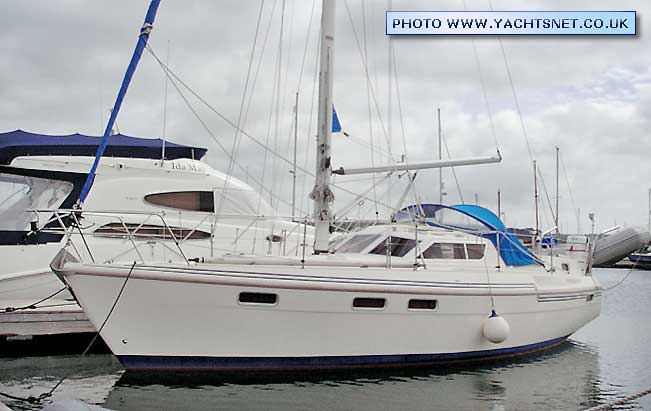
Well, she isn't drop dead gorgeous but she's not a minger either.

Most examples seem to have the deck above the aft cabin finished in teak. That's OK if it's in good condition but replacing it could be costly. There are, however, cheaper alternatives.
The cockpit looks well laid out with a good seating arrangement for the helm (often complete with cushions in other examples seen online). The lack of a secondary winch to starboard seems a little odd but I'm guessing this boat is not set up to fly a kite and the secondary winch to port is probably set up for handling the genoa roller reefing
I'd be looking to add a pod for a chart plotter, or if money permitted a networked multi-function display, above the steering binnacle but that's no big deal at least technically

There's plenty of vents and hatches on deck but there's still space for some solar panels which we'd be wanting to keep the batteries topped up (I'll come back to that in a bit).
The mainsail sheeting arrangements may be a little compromised for ideal performance but they do keep the whole arrangement out of the cockpit and well away from the appendages and outlying regions of the crew!
In then we have that devils curse - the in mast furling mainsail. Well, according to some it is a devils curse. I am not, frankly, so sure. Yes, it does somewhat compromise the ability to shape the sail to the last teeny bit of perfection and yes, if it goes wrong it could be a nightmare
But in reality just how often does a properly maintained and properly used in mast furling system fail? And consider the advantages of being able to set, reef and stow the main with the same ease as a roller reefing genoa! No more fighting with acres of billowing stiff sail cloth trying to persuade it to lay on the boom. No more bruises from flying sail ties. No more soggy wet sail covers to stow and handle
What, I say again, is not to like?
Right forward we've got an anchor well which houses the windlass and so on.. Actually, I'm not sure what advantage putting this lot in a well really offers but it doesn't greatly matter
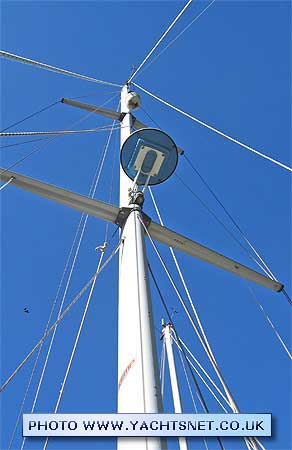 The mast is a conventional twin spreader masthead rig of conventional design
The mast is a conventional twin spreader masthead rig of conventional design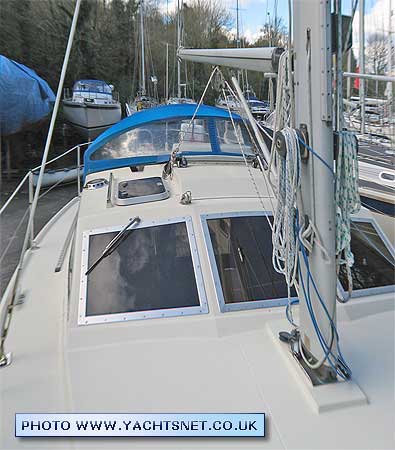 There looks to be good conditions for working on deck with plenty of hand holds although I would be looking at the availability of clip on points as you transition from the side decks to the mast and fore deck areas where there seems to be a lack of hardware on this boat at least
There looks to be good conditions for working on deck with plenty of hand holds although I would be looking at the availability of clip on points as you transition from the side decks to the mast and fore deck areas where there seems to be a lack of hardware on this boat at leastMoving right aft, there is space on the stern deck for a canister life raft (although I would prefer it mounted outboard of the pushpit rail and I'd also consider fitting it on the aft deck with an automatic release)
Many examples of the type have dinghy davits fitted and that is a good thing because one area where the design is compromised is in respect of "gear storage".
There is one large locker under the cockpit seat to starboard and that's the lot so being able to keep the dinghy on davits would be a plus
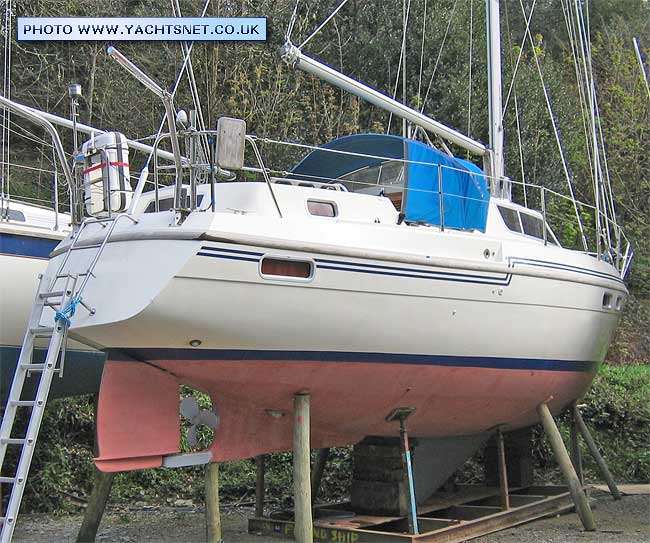
In any case, the usage we envisage would likely mean the dinghy being used quite a lot - we'd be anchoring off whenever possible and only going into costly marinas when we needed to - so being able to keep it ready for immediate use on davits would suit us perfectly.
If for some reason we needed to stow the dinghy, it would have to be lashed on deck
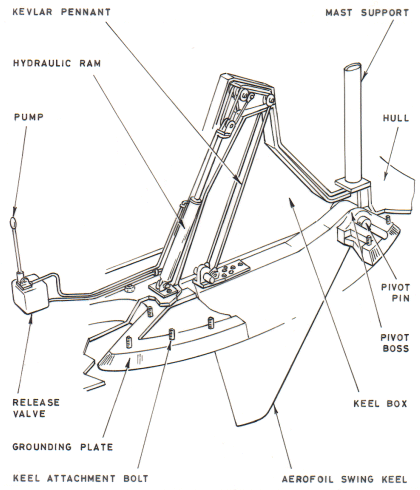 Finally, we come to one of the biggest pros, and by no coincidence also one of the biggest cons, of the design.
Finally, we come to one of the biggest pros, and by no coincidence also one of the biggest cons, of the design.In common with all Southerlys, the 115 has a aerofoil section cast iron lifting keel mounted into a cast iron grounding plate, the two combined being the ballast. The keel is lifted by means of a hydraulic ram powered by an electric pump with a manual backup and it can be locked in the raised or lowered position
With the keel up in standard trim, the 115 draws just 2'3", six inches less even than "Brigantia" and fully nine inches less than "Erbas"! She can happily dry out on any flat surface - mud, sand or gravel - with the keel up
The keel position can be seen through the box by the galley
With the keel down she has a good reputation as a sailing boat although the 115 Mk.1 does have a tendency to be hard to steer in a heavy quartering sea due to her rather shallow rudder design.
Later versions of the 115, along with other newer Southerlys, had a twin rudder design to overcome this problem (however, they are much more expensive to buy and design changes below decks are not ideal for our needs)
The problem really only manifests itself in conditions that would have us staying in shelter anyway and can be overcome by altering course or motor sailing if necessary

Oh and there is a very rare ketch version too ...
Although whether the extra cost and complication is worthwhile is another matter. This example also has twin headsail furlers with a big light winds genoa outboard of the working genoa (an idea I'm toying with for "Erbas" as it happens"
So there we have it, the Southerly 115
It's not a gaffer, it's not made of wood, it's not sexy and it won't turn heads or win races
But it's a boat I could see us living on all year round and cruising all over Northern Europe for many years
In the next instalment I shall explain why I've decided to buy a Thames Sailing Barge, or perhaps not!!!
P.S. Sanity shall return shortly with actual serious plans for sailing in 2015 plus the occasional mention of my foray into working on other people's boats to pay for my sailing rather than making travellers cups of coffee for a living!
P.P.S. I KNOW there are other lifting keel boats out there, some of them might even be better than the Southerly. Some of them might even be as affordable (or not) as the Southerly. This is an exercise in idle speculation though so it doesn't really matter! Although if we win the lottery ....




No comments:
Post a Comment